|
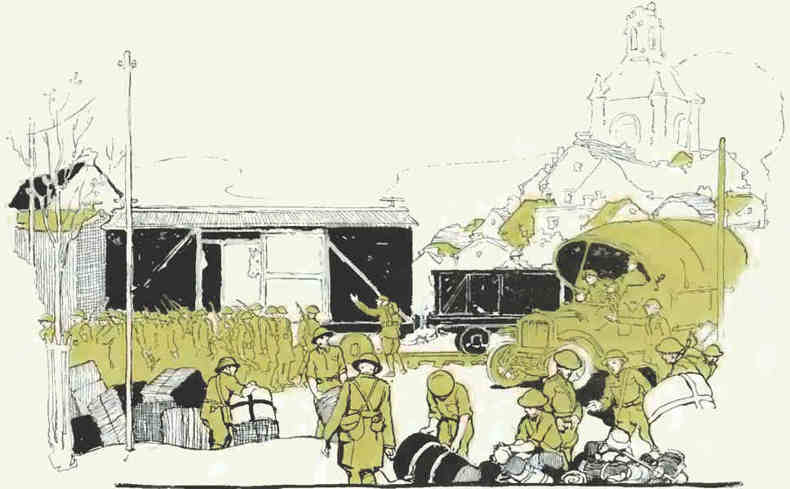
The Order Was given lo Detrain
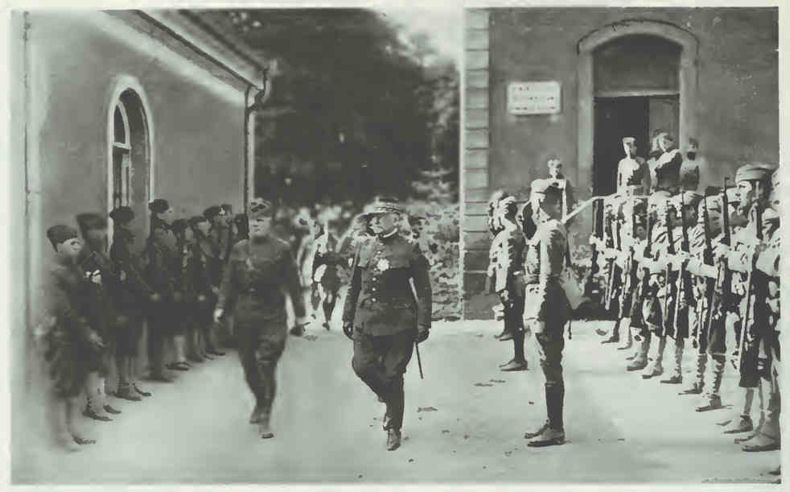
General C.C. Geran, Accompanied by Major General Duncan, 77th Division, Passing the Guard of honor
Baccarat, June 26, 1918
Division, it was the opportunity of feeling and strengthening in a personal way the bonds that bind two peoples
together.
This first meeting with the French was an event of special significance to the Division, but the actual entry into this sector had a much greater
significance. The 77th was to be the first National Army Division to take over part of the front line. It was the first real test of a great
experiment. It was to determine whether an army recruited from the motley ranks of civilian life
could, within a few brief months, be trained into an effective fighting force. It was to forecast whether the natural assets of initiative,
alertness, courage and determination could be matched against the iron discipline of a great war machine.
To the officers, it meant leading men for the first time under the strange and difficult conditions of actual
battle; not men trained and seasoned to war, but men who a few months before had never worn a
uniform. To the men, it meant obedience under adverse conditions, conditions in which to falter might mean
disaster. To both officers and men, it meant adaptation to new surroundings and unusual conditions. Afterward it became a source of deep satisfaction to the 77th that it was the first National Army Division actually to have a sector and to face the Hun on the western front.
To many men, the much-used word, relief, meant but little. In a vague way, they knew that somehow the 77th was to get into the position now occupied by the 42d. An opinion was current that the Division would suffer more in taking up its new positions than in holding them for several months after the men were once in fine.
The relief was completed between the 16th and 26th of June. For a week the weather continued sultry and rainy with low-hanging clouds of mist and fogs which materially assisted the
movement, by permitting the free and safe use of trucks and motor transport. All movements of the troops were restricted to night-time, and every precaution was taken that the relief should not be discovered by the
enemy.
Despite all precautions, the enemy was aware that a relief was in progress. He only awaited the Division's safe
arrival, to give it a warm welcome. From his observation balloons floated messages of
felicitation, "Good-bye, 42d Division - Hello, 77th Division," and on the morning of June 24th, when the relief was practically
complete, he started his real celebration of the event.
At 4 A.M. he began shelling with mustard and phosgene gas. Migneville, St. Maurice,
Montigny, Newviller and Badonviller were the places most concentrated on, but scattered and random shots were dropped throughout the
area. This was the Division's first experience with gas. Without stopping to recall the old familiar admonition,
"It is your best friend," the masks were put on in double time and without thought of number and prescribed
manner. During this attack, the enemy artillery fired approximately three thousand rounds which resulted in 180
casualties. Of these, about one hundred were severe, five being the result of phosgene and the rest of
mustard. It was ascertained later that the casualties were nearly all due to removing the masks too
soon, rather than to tardiness in putting them on, and this first lesson learned by experience was destined to help many times in the future.
The Baccarat sector was in Lorraine, south of Strasburg, on a fine between Luneville and St. Die. The part held by the 77th Division extended from Herbeviller on the left to a point east of Badonviller on the right. This
sector, which was named for its largest town, was divided into the East Zone and the West Zone with the dividing line between Ancerviller and St. Pole. Each zone was divided into two
sub-sectors, named La Blette, Montigny, St. Pole and Badonviller sub-sectors, held by the 305th
Infantry, 306th Infantry, 307th Infantry and 308th Infantry from left to right. Each
sub-sector was organized into a one-battalion front with one battalion in support, and one reserve battalion in
rest. The front extended in a general northwesterly to southeasterly direction, with the little towns of
Domevre, Halloville, Nonhigny, Montreux and Bremenil included in the German
lines. The 77th Division Headquarters were established in Baccarat on the morning of June 21st.
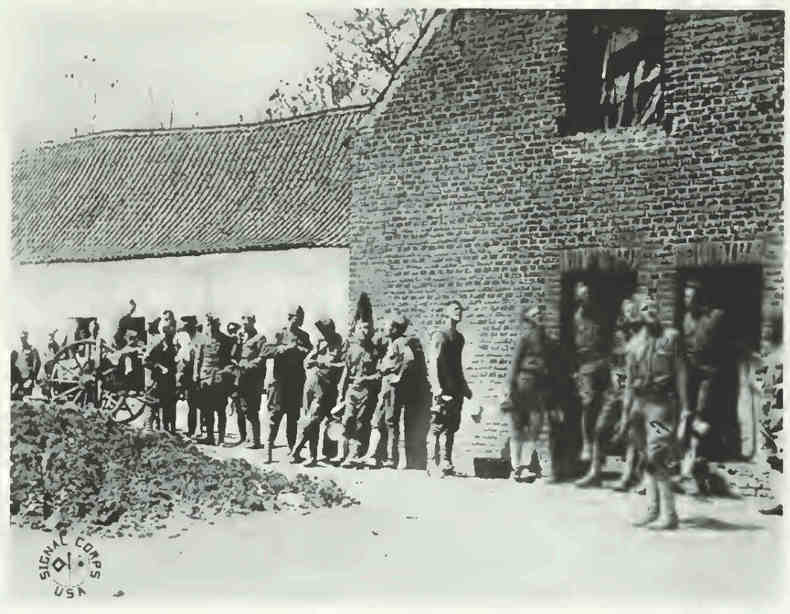
Watching an Enemy Aeroplane
The terrain of the sector is well adapted for the training of a new division. It is
broken, hilly, partially wooded country with no part offering extreme
difficulties, but all parts affording excellent opportunities for teaching, training and developing the various branches of an inexperienced army by practical work in the field. Three water courses cross the
area, each dignified by the name of a river. The Meurthe is the largest of
these, and entirely traverses the sector, flowing through Baccarat to the northeast in a line parallel to the front. Between the Meurthe and the front line, two other small
streams, the Verdurette and the La Blette rivers, flow in the same general direction.
Only the lower, less rugged slopes are cultivated. Many of the hills are rocky and either wooded or partially covered with thickets of hedge-thorns or other
shrubs. From an elevation of vantage one can look to the east far over the billowy tops of hills and
ridges, rising ever higher and higher, until lost in the distant haze-veiled peaks of the Vosges. The roads stand out white and distinct against the verdure of
summertime, disappearing and reappearing as they wind like ribbons of silver about the
valleys, from one quaint old-fashioned village to the other.
To the lover of nature, it was a beautiful country in a beautiful season, but its aesthetic charms were often unappreciated during the sordid tasks of a "quiet
sector." It was no strange sight to see peasants with gas masks working on the reverse slopes of hills within three kilometers of No Man's Land.
The front of each sub-sector was organized in two lines of defense. The first or front line was at first strongly
held, but this was later changed to a line of out-posts or strong-points, each held by one,
two, or three squads of men. The second line or main line of resistance was more strongly
occupied. In case of attack, the forward out-posts were to offer strong resistance and fall back to the second line. The support
battalion, in turn, was always ready to move to the support of the forward
battalion.
Each battalion held the forward area for a week or ten days and was then relieved by the support
battalion. After being relieved, it moved to the rest camp in the rear. At the next relief, it left the rest camp and took position as support
battalion.
The birthdays of the United States and France were celebrated while in this
sector. On the night of July 3d, word came that an attack might be attempted. It had been customary for the enemy thus to help the Allies celebrate their
birthdays. The whole Division went into the alert, but the alarm was false. On the following
day, the French celebrated in honor of the Americans. Officers were feasted, smokes were
exchanged, and many a patriotic toast was drunk to the success and friendship of the two nations.
On July 11th, the Americans returned the courtesy, and in all modesty, it may be
said, the first celebration was outdone in true Yankee style. These sincere expressions of courtesy and goodwill fixed more firmly the kindly feeling of sympathy that had been steadily growing between the men of the Division and their French
comrades.
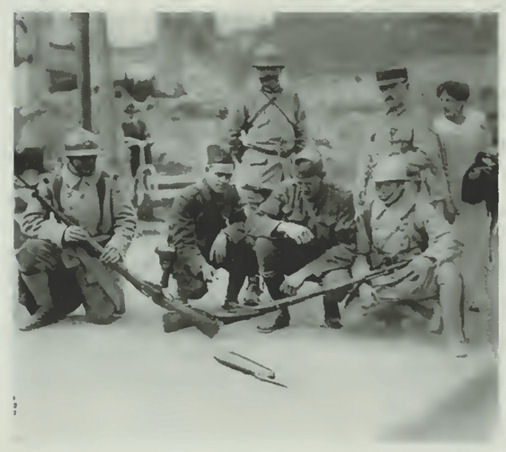
French and Americans Equally Interested in Aeroplane Dud
Rapid progress was being made in the course of the training; more and more responsibility had been given the 77th, until between July 15th and July 18th the French Division was gradually withdrawn from the
sector. Each battalion had held the front-line position with the French, and each had received the benefit of their instruction. From now on, the American
Division would act entirely on its own responsibility. It had won the confidence of its
instructors; without assistance, it would hold part of the great front line.
Patrols accomplished the only really aggressive work in this area. Nearly every night, each
sub-sector sent out a patrol. Some of these were to repair wire ; some were to reconnoiter certain areas for machine-gun emplacements; some were combat
patrols; and there was always the standing order to take prisoners, if possible. At
first, these patrols consisted of forty or fifty men composed of both French and
Americans. Later the patrols were much smaller.
The experience was of value. Soon the troops became accustomed to patrolling cautiously about "No Man's Land" in the
darkness, stopping and listening intently at the least sound, always expecting the enemy
flares, and ever ready to drop at the first "rat-tat-tat" of a machine
gun. Several German patrols were repulsed and driven off with losses. At one time, one of the American patrols met an enemy patrol of greatly superior numbers and exchanged courtesies. As a result, some were reported missing, but the following night all had returned after an eventful day and night spent in shell holes and enemy
trenches. Despite cunningly laid ambuscades, all efforts up to now to take prisoners proved
fruitless. The only direct information received of the enemy was from three deserters who wisely left their guns in a wire entanglement and with uplifted hands walked victoriously into the American
lines.
A patrol was undertaken on July 21st, by Captain Blanton Barrett of the 307th
Infantry, for the purpose of taking prisoners. The party of fifty-four had already passed the enemy
wire, which had been previously cut, and were just entering the woods beyond. Immediately following
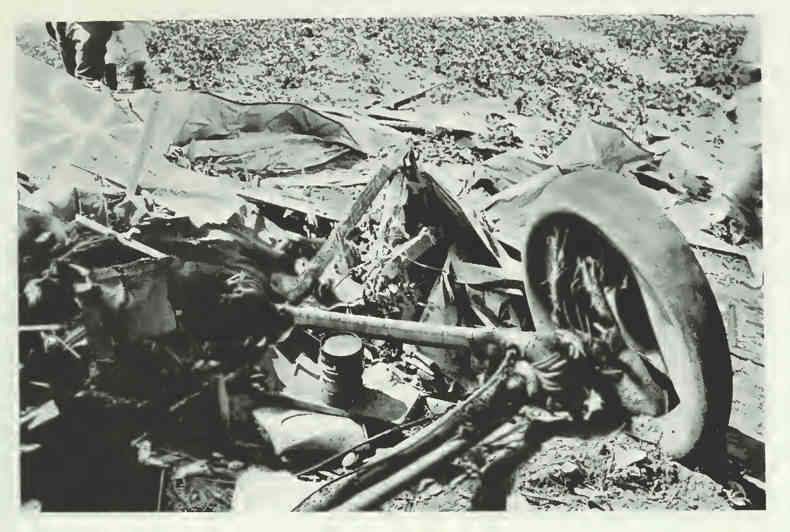
The Enemy Had Superiority of the Air-Enemy Plane Brought Down Near Chapelle, July 5, 1918
blast of a bugle, the patrol was attacked on two sides with rifle, machine-gun and grenade fire by two companies of the
enemy. The fight was brief but furious and the courage of the Americans
magnificent. Fire was returned with undaunted determination and an attempt to surround the patrol was
frustrated. Of the men who originally constituted the patrol, only twenty one
returned. Nearly all of these were wounded. Captain Barrett, after being severely
wounded, continued fighting until killed.
Patrols had previously entered to the third-line trenches of the enemy without opposition and there was no reason to expect such a strong force at this point at the time. The encounter had demonstrated one very significant fact. The
soldiers, though unseasoned and but partly trained, had the fundamentals of real
warriors. They evidenced the unfaltering courage, unbreakable determination, and indomitable spirit that were to characterize the Division throughout the war. They were
dependable. They needed only more experience and a closer binding together into a smoothly working machine to make an irresistible fighting force.
The enemy had the superiority of the air, which in certain respects served well in the training. Whenever visibility was
good, a line of balloons could be seen along the entire front. Kitchens had to be concealed
carefully. Movements of troops had to be restricted to night-time. Every action had to be performed with greater
secrecy, and greater precautions had to be exercised at all times. An observer was always on the
lookout, and whenever an enemy was sighted he gave a long far-reaching blast of the bugle. The familiar
"under cover" was heard here for the first time. When the plane
disappeared, three short blasts were blown and interrupted activities were again
resumed.
Every branch of the Division had an opportunity to apply the instruction it had received before coming to the
sector. Not only the doughboys, but the Intelligence Branch, the
Machine-gunners, the Artillerymen, the Engineers, the Signalmen - all here received the same valuable
experience.
Better conditions for developing the intelligence section could hardly be
found. Difficulties of terrain taxed the ingenuity in selecting observation
posts, but when once the system was organized, it developed real
effectiveness. To develop the powers of observation and give more practice, everything that occurred in the enemy lines was
reported. Reports were required on all enemy shelling, calibre, source and destination. All balloons and planes were scrupulously
noted. Despite these seemingly trivial requirements, much good work was
accomplished. Many enemy strong-points and gun emplacements were located and reconnoitered at night. One sniper's post was discovered in a church with a dummy decoy at a neighboring
window. When the figure was shot at, a concealed German with a sense of humor waved a red flag to indicate that the shot had been a "miss."
The machine-gunners, destined to play an important role, here found their first practice in cooperating with the Infantry in selecting and preparing gun positions. The regimental machine-gun companies were
used, together with companies of the Machine-gun Battalion; with one company always working with each
battalion. They were relieved when the battalion was relieved and worked also in conjunction with the French. This gave each company experience on every line of
defense. The companies did most effective work with patrols, and often gave protecting fire when not actually
participating.
The Division Machine-gun Companies did not come into action until late in July. Half were used by each brigade, and they made an important part of the scheme of defense in the
sector. They had permanent emplacements from which they could, if called
upon, sweep the whole of the enemy front, but they did much firing from other temporary positions. On alternate
nights,
each company fired a barrage of approximately ten thousand rounds on established
strongpoints. Several enemy machine-gun nests were destroyed.
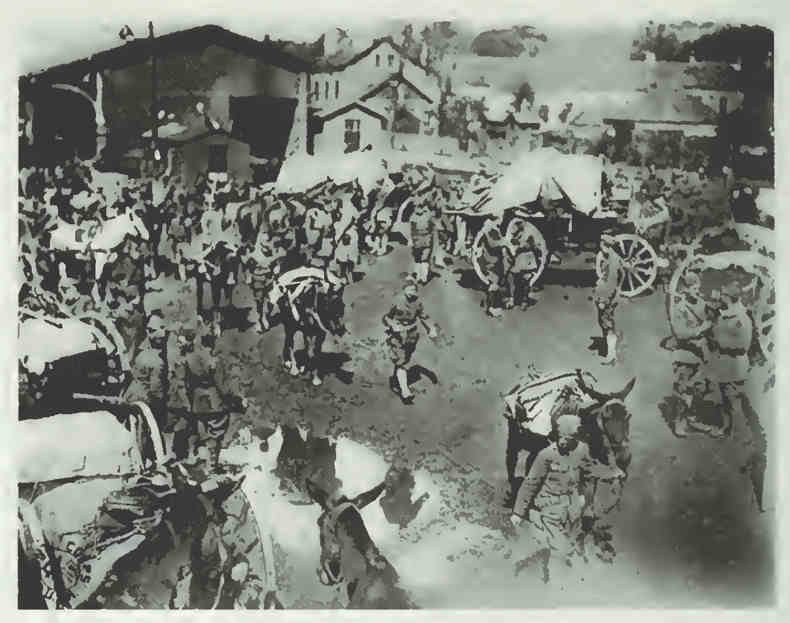
Once More the 77th Was on Its Way
For supporting artillery, the Division was dependent upon the French during most of its stay in Lorraine, as the Divisional Artillery did not arrive until the middle of July. Every day there was some firing on known battery positions and sensitive points, and also some harassing
fire, but at no time, excepting in the first gas attack, was there heavy artillery fire on either
side. American fire averaged more than double that of the enemy. The most notable achievement of the artillery was the firing of a suspected ammunition dump in a ruined church. The firing proved the truth of the suspicion, and at the same time proved the worth of the training at Camp de Souge.
Liaison was not neglected. Signalmen entered the area in advance of the other branches, and were functioning when the other units
arrived. Within the sector, the telephone, supplemented by a runner system, was the chief means of
communication. Each battalion was connected with higher units by telephone. Each unit down to platoons had its trained runners who were familiar with all the Posts of Command to which they might be expected to go.
Motorcyclists, bicyclists and mounted couriers were also used in conjunction with this. Later a visual system was established and
maintained, using wig-wag, semaphore and flash-lamp. This was always ready in case the other systems should fail. A wireless system was set up and worked
successfully. Besides these means of liaison which established a network of communication throughout the
sector, carrier pigeons were used. Linemen and couriers were learning to work under
fire; operators became proficient; officers learned the use of the code.
Such was the sejourn in the Baccarat Sector. Every man had received a useful training. As a
whole, six weeks had been without particular incident, but they were six weeks well
spent. First impressions are lasting, and the long nights of alert waiting, the rattling bursts of machine
guns, the brilliant trains of colored flares, the endless stretches of wire
entanglements, the shell-torn expanse of "No Man's Land," the ever-staring enemy
lines, the watchful balloons hanging above the wooded hills, the weird singing of
shells, the tell-tale clatter of duck-boards, echoing in the stillness of the night, the rest camps - they had all made an indelible impression.
The end of July completed the stay in Lorraine. The relief was successfully accomplished by the 37th Division, and once more the 77th was on its way to the future. It had served its apprenticeship on the quiet
sector. The stay had been characterized by continuous activity and training. Valuable experience had been
acquired. A spirit of self-confidence was being developed. But so far, the force of the Division was
potential. It still lacked consolidation into a smoothly functioning whole. In its elements it had found
itself, but in its entirety it was not yet capable of expression in full dynamic force.
|







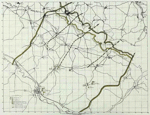
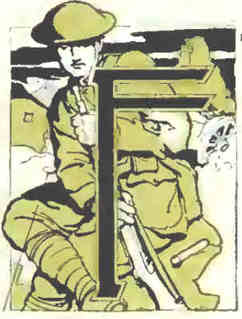 FOR three days the tired doughboys had been riding on the slow-moving trains of France. They did not know whither they were bound, or what the future held in store, but by observing the sun and noting the names of the more important cities, it was well established that their journey was taking them south and east. There were visions of guard duty on the Mediterranean; and attractive stories of sunny Italy were told and retold. The city of Nancy had been passed many hours before, when the order was given to detrain at an insignificant town, of which no one had ever heard. Two days of hiking followed, and the different units were fmally all grouped in the vicinity of Rambervilliers. It now became generally known that the 77th was to occupy a quiet sector at the front and rumor had spread through the ranks that the 42d Division would be relieved.
FOR three days the tired doughboys had been riding on the slow-moving trains of France. They did not know whither they were bound, or what the future held in store, but by observing the sun and noting the names of the more important cities, it was well established that their journey was taking them south and east. There were visions of guard duty on the Mediterranean; and attractive stories of sunny Italy were told and retold. The city of Nancy had been passed many hours before, when the order was given to detrain at an insignificant town, of which no one had ever heard. Two days of hiking followed, and the different units were fmally all grouped in the vicinity of Rambervilliers. It now became generally known that the 77th was to occupy a quiet sector at the front and rumor had spread through the ranks that the 42d Division would be relieved.




